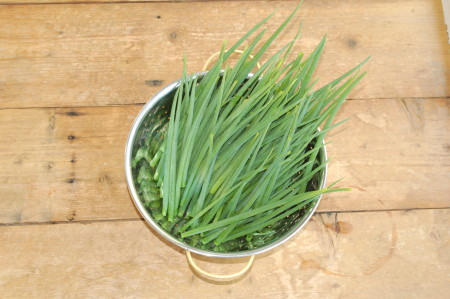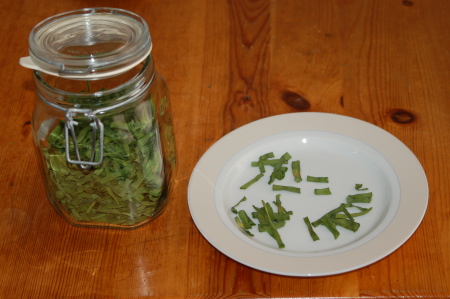
These are mostly Amish Onions, with a few Egyptian Walking Onions mixed in.
I’ve posted before about perennial onions, and now in my garden I have Amish, Egyptian Walking and Fleener topsetting onions. The Fleener onions aren’t doing well right now, and struggling along.
I’ve been growing perennial onions for a few years now, and I really like them. Basically you can eat any part of the plant you want to, at any time. The onions I have now are all topsetting onions, and leading up to the summer solstice will send up a scape similar to a garlic scape and form topsets that can be eaten or replanted for more plants. Sometimes the plants also form root divisions. You can leave the plants in the ground, and they will continue to produce new topsets year after year. Anytime you want, you can dig up the whole plant and eat the root which is an onion with a unique and special taste, but then the plant will be gone.
The plants are very disease resistant, so it’s not necessary to rotate them and they can be left in the same spot year after year. They also tolerate transplanting very well, and can be dug up and moved almost anytime. They are carriers of some of the same diseases that are a problem for other members of the Allium family like garlic and onions, so where you grow them has to be taken into account when planning crop rotations for these other plants.
Honestly, if you don’t like eating onion greens, this kind of onion is probably not for you. The greens are the best part, and really have a nice taste. The greens are also available early in the spring, when there aren’t often other sources of onion available. The roots and topset, while edible, are not really spectacular.
I am still trying to find the best way to serve the greens. The flavor is wonderful, but delicate and easily overwhelmed by other food flavors. They disintegrate quickly when cooking. So far, I have enjoyed them most in salads (as long as you don’t have a strong tasting dressing), as well as a garnish in many places.
Except for the handful that went into dinner, the onion greens you saw in the picture above, after going through my dehydrator, became this:

They turned into something similar to dehydrated chives.


Yesterday, I stuffed some of my fat stems from my egyptian onion with ricotta mixed with olive oil, salt, and freshly ground pepper. I took a whole stem and made a parchment paper cone and squeezed the mixture into the onion’s tube-like leaf. Then I cut the whole leaf into one-inch lengths. The sweet onion green and the dairy goodness worked together to make a great little appetizer. That may be another way you enjoy eating the multiplier onions.
Happy weekend!
It’s great to hear about your experiences with perennial onions. I grow both topsetters and nesting, and harvest our native allium tricoccum (in Vermont in the US). Rather than cooking with green onions (like you say, they fall apart and the distinct flavor is lost) I add them to the bowl or plate, and pour the hot stuff (soup, bean stew, whatever) on top of them to serve. It’s just enough heat to bring out the flavor more than if you put them on top as a garnish, but not enough heat to break them down. Actually we eat all kinds of greens and herbs either that way or as salad. I can’t abide overcooked vegetables….
This are both great suggestions! Thanks.
My onions are a little too small now to think about stuffing them, but I guess by the end of summer they will be much bigger.
Leigh: Your blog looks great so far! I’m happy to come across another seed saver, and thanks for leaving the comment. I’m looking forward to reading more about your garden.
I’m ready to start my first dehydrating of carrots, but am reading different ways to do this. One article says that you only need to blanch the carrots before dehydrating while another says to blanch with sodium bisulfite then dip in cornstarch water before drying. Which is the best way?
Thanks
Hi Diane,
I’m still experimenting with carrots, so I’m not really sure.
I had read somewhere that you didn’t need any pre-treatment, so I tried this with thin slices, but it turned out not to work well. The rehydrated carrots were tough and stringy.
I think the next time I’ll try it with just blanching, perhaps with a small batch first.
If you have a chance to come back and leave another comment after you try it, I’d love to hear what your experiences are.
i am wanting to get started with fleener onions,
or amish onions or any kind of topsetting onions,
if anyone has any to let go please let me know,
rush williamson
po box 1927
inez,ky. 41224
i’ll email you this summer to remind you to send me
some topsetting onions, like amish and egiption
topset onions. thanks, rush williamson
po box 1927
inez,ky. 41224
I have Egyptian Walking Onions in my garden for the first year, they were planted from topsets last summer. They have some topsets and many of those are sprouting. We had a heavy rain last week and now several of them have bent over half-way. Is this something that should be happening now? Or could it be because of that rain? The topsets do not look as large as the ones that I planted. I live in Texas in zone 8.
Hi JUF,
I’m not sure where your topsets came from, but it’s normal with any plant that suddenly gets grown in a new climate to take a few years to become acclimated. I would give it at least another year or two before you give up hope.
Normally topsets form with the summer solstice, so I think yours are a little early. This could be because they are stressed somehow. Perhaps they are planted too close, or you are using fertilizer or something else they don’t like. These onions like lots of compost, if you have it available.
After topsets are mature, the stems normally begin to brown a bit then bend over. If they bend over before turning brown, it could be the plants are weak for some reason.
As well as topsets, the plants can often be propagated with root divisions. When you see a cluster just dig it up, break into pieces and replant. You should only break into pieces plants that are fully separated, and not still enclosed in it’s skin.
I hope this help.
Hi Patrick the Amish onions you gave me have REALLY taken to my garden, having a ball producing tons of top sets and seem to divide twice in the year! i really love eating them all through the year so great stuff. Best recipe I have for them so far is a korean one – of thinly sliced green onion soaked in cold water then given a hot dressing i posted the recipe on my blog http://kitchengardenrecipes.wordpress.com/2011/08/06/green-onion-relish-korean/
also i’ve been meaning to ask you where the Amish Onions came from originally i can’t find much info on them and I’m not even sure of their latin name – do you have any more info? Same for the Egyptian walking onions which have not taken off in the same way but are still good and I’f like to know more. Also do you have any Allium Ampeloprasum that I know as (Broadleaf) Wild Leek but some people might refer to it as elephant garlic.
Hi Laura,
I’m really glad the Amish onions are doing well!
I got the Amish onions from a member of the US Seed Savers Exchange several years ago. They were only offered the year I requested them, and I have not been in contact with the member since or know anyone else who has contact with them.
The SSE is known to have very old members, sometimes with very rare plants, and varieties are know to get lost because no one requests them and the members get too old to keep up their gardens or pass away. I think that might have been what happened here.
In any case I have never encountered them in any garden or any seed catalogue since. I have been contacted myself from people who said they saw the listing in the SSE catalogue, and intended to request them but didn’t.
I think the people I’ve shared the onions with may be the only ones still keeping it alive. By it’s nature it can’t be kept in a seed bank, because it has to be regrown every year, so I don’t think it’s in any seed banks either. I haven’t shared it with that many people! Maybe 4 or 5.
It’s not doing well in my garden at the moment, that bed was over taken by weeds this year and last. I’m pretty sure I still have a few left, but the day may come where I have to ask you for some back. Please keep growing it, and share it with as many people as possible! I think the Latin name is the same as the Egyptian onion, Allium cepa var. proliferum.
The leak you’re looking for is called ‘oerprei’ in Dutch, meaning ‘Ancient Leek’. I had it one year but didn’t understand what it was. I ate the whole plant, didn’t think it tasted good, and so got rid of it. In fact you’re supposed to just eat the leaves. I keep meaning to try again, but haven’t got around to it. I think Lieven and Frank both have this in their garden:
http://www.lusthof.org
http://www.thevegetablegarden.be
many thanks for the info Patrick cricky! – I have passed on quite a bit this year as it grew so well mostly to neighbours. I will make sure i get it started in my best friends garden in London too for safety. I have a few bulbs left if you want some this year? I will be leaving Mas du Diable next June – it is going to be an unbelievable wrench but have started the process of cataloguing my seed. I will contact HSL and see if they would like some of these bulbs. Did you find the Amish grew better than the Egyptian top-setters? and what were the main differences you found – I just want to be sure i’ve kept them seperate.
cheers Laura
Hi Laura,
Yes, they do grow stronger than the Egyptian onions, and I think overall plain better.
I can tell them apart from the taste. It’s hard to tell the plants apart just by looking at them, they really look similar. The greens of the Amish onions are a little stiffer, rounder and the walls are a little thicker. This is just from memory, I don’t have one of each right now to look at.
I was pretty sure I had them the right way round – but good to get what sound like confirmation – thanks Patrick. i planted them at either end of the long potager to make sure of good seperation with labels but wild pigs (when they got in a couple of years ago) chewed up the plastic labels!!! I’ll put up a post about these onions soon as it would be good to share the info and pictures we have.
Laura